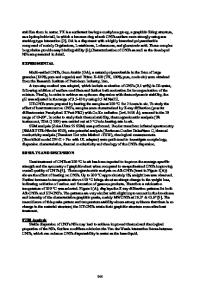Preparation and dispersion stability of aqueous metal oxide nanofluids for potential heat transfer applications: a revie
- PDF / 1,414,310 Bytes
- 24 Pages / 595.276 x 790.866 pts Page_size
- 91 Downloads / 367 Views
Preparation and dispersion stability of aqueous metal oxide nanofluids for potential heat transfer applications: a review of experimental studies Adnan Qamar1 · Zahid Anwar1 · Hassan Ali2 · Rabia Shaukat1 · Shahid Imran1 · Attique Arshad1 · Hafiz Muhammad Ali3 · Theodosios Korakianitis4 Received: 4 July 2020 / Accepted: 16 October 2020 © Akadémiai Kiadó, Budapest, Hungary 2020
Abstract Nanofluids have recently attracted attention of many researchers due to their growing potential applications in heat transfer devices. They possess extraordinary thermal and rheological characteristics compared to the respective base fluids. However, the preparation of nanofluids and their dispersion stability is a matter of serious concern, several research investigations have been done in the present era to address these issues. Through this review article, an attempt has been made to critically analyze the published literature on the preparation and dispersion stability of different kinds of aqueous metal oxide nanofluids. In this context, general preparation and stabilization methods, types of instruments for stability inspection, as well as factors affecting stability of aqueous metal oxide nanofluids, are discussed in detail. The current research needs, possible solutions to research challenges in exploring uniformly dispersed nanofluids under optimized operating conditions is the heart of this review article. An effort has been made to determine the status as well as the possible future directions, the preparation and stability related research may take. Keywords Aqueous · Metal oxides · Nanoparticles · Nanofluids · Stability · Surfactants
Introduction Heat removal in modern high-tech equipment such as lasers, power electronics, computer chips, evaporators, and condensers is a major concern and therefore has a significant effect on technological development of these devices. The cooling demand for high-tech equipment cannot be fulfilled with existing conventional solutions such as changing the heat transfer surface geometry, surface area, as well as fluid * Zahid Anwar [email protected] 1
Department of Mechanical, Mechatronics and Manufacturing Engineering, New‑Campus, University of Engineering and Technology Lahore, Lahore, Pakistan
2
Department of Mechanical Engineering, Rachna College of Engineering and Technology, University of Engineering and Technology Lahore, Lahore, Pakistan
3
Mechanical Engineering Department, King Fahd University of Petroleum and Minerals, Dhahran, Saudi Arabia
4
Parks College of Engineering, Aviation and Technology, Saint Louis University, St. Louis, USA
flow rates [1]. Transport properties of heat transfer fluid (HTF) have significant effect on overall heat exchange process. Conventional HTFs have limited heat-carrying capability, one possible scheme to enhance their thermal performance is with the addition of small concentrations of very fine metallic and nonmetallic solid particles having high thermal properties [2]. This possibility has existed for decades, but the unavai
Data Loading...










